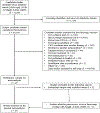A meta-analysis of cognitive-behavioral therapy for alcohol or other drug use disorders: Treatment efficacy by contrast condition
- PMID: 31599606
- PMCID: PMC6856400
- DOI: 10.1037/ccp0000447
A meta-analysis of cognitive-behavioral therapy for alcohol or other drug use disorders: Treatment efficacy by contrast condition
Abstract
Objective: This meta-analysis examined 30 randomized controlled trials (32 study sites; 35 study arms) that tested the efficacy of cognitive-behavioral therapy (CBT) for alcohol or other drug use disorders. The study aim was to provide estimates of efficacy against three levels of experimental contrast (i.e., minimal [k = 5]; nonspecific therapy [k = 11]; specific therapy [k = 19]) for consumption frequency and quantity outcomes at early (1 to 6 months [kes = 41]) and late (8+ months [kes = 26]) follow-up time points. When pooled effect sizes were statistically heterogeneous, study-level moderators were examined.
Method: The inverse-variance weighted effect size was calculated for each study and pooled under random effects assumptions. Sensitivity analyses included tests of heterogeneity, study influence, and publication bias.
Results: CBT in contrast to minimal treatment showed a moderate and significant effect size that was consistent across outcome type and follow-up. When CBT was contrasted with a nonspecific therapy or treatment as usual, treatment effect was statistically significant for consumption frequency and quantity at early, but not late, follow-up. CBT effects in contrast to a specific therapy were consistently nonsignificant across outcomes and follow-up time points. Of 10 pooled effect sizes examined, two showed moderate heterogeneity, but multivariate analyses revealed few systematic predictors of between-study variance.
Conclusions: The current meta-analysis shows that CBT is more effective than a no treatment, minimal treatment, or nonspecific control. Consistent with findings on other evidence-based therapies, CBT did not show superior efficacy in contrast to another specific modality. (PsycINFO Database Record (c) 2019 APA, all rights reserved).
Figures




References
-
- American Psychiatric Association. (1987). Diagnostic and statistical manual of mental disorders (3rd ed., test rev.). Washington, DC: Author.
-
- American Psychiatric Association. (1994). Diagnostic and statistical manual of mental disorders (4th ed.). Washington, DC: Author.
-
- American Psychiatric Association. (2000). Diagnostic and statistical manual of mental disorders (4th ed., text rev.). Washington, DC: Author.
-
- American Psychiatric Association. (2013). Diagnostic and statistical manual of mental disorders (5th ed.). Washington, DC: Author.

